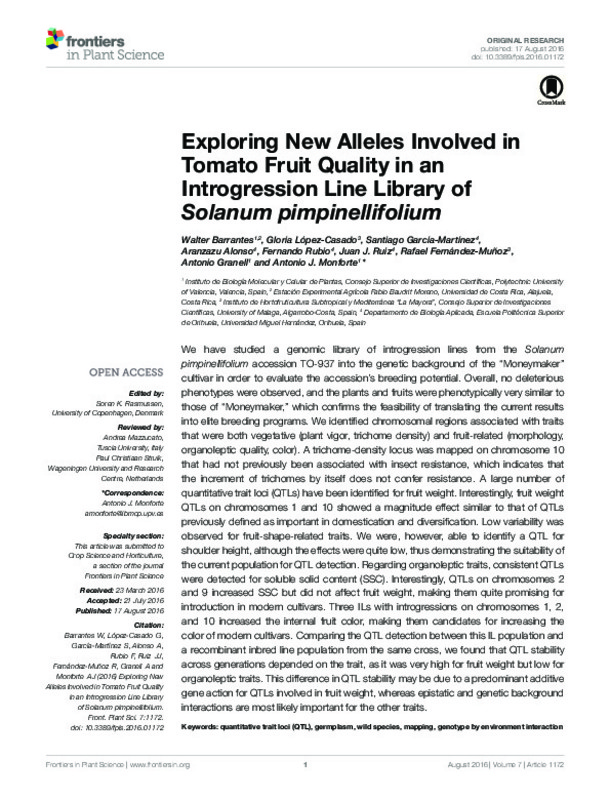JavaScript is disabled for your browser. Some features of this site may not work without it.
Buscar en RiuNet
Listar
Mi cuenta
Estadísticas
Ayuda RiuNet
Admin. UPV
Exploring New Alleles Involved in Tomato Fruit Quality in an Introgression Line Library of Solanum pimpinellifolium
Mostrar el registro sencillo del ítem
Ficheros en el ítem
| dc.contributor.author | Barrantes-Santamaria, Walter
|
es_ES |
| dc.contributor.author | Lopez-Casado, Gloria
|
es_ES |
| dc.contributor.author | Garcia-Martinez, Santiago
|
es_ES |
| dc.contributor.author | Alonso, Aranzazu
|
es_ES |
| dc.contributor.author | Rubio, Fernando
|
es_ES |
| dc.contributor.author | Ruiz, Juan J.
|
es_ES |
| dc.contributor.author | Fernandez-Munoz, Rafael
|
es_ES |
| dc.contributor.author | Granell Richart, Antonio
|
es_ES |
| dc.contributor.author | Monforte Gilabert, Antonio José
|
es_ES |
| dc.date.accessioned | 2017-05-15T10:22:56Z | |
| dc.date.available | 2017-05-15T10:22:56Z | |
| dc.date.issued | 2016-08-17 | |
| dc.identifier.issn | 1664-462X | |
| dc.identifier.uri | http://hdl.handle.net/10251/81128 | |
| dc.description.abstract | We have studied a genomic library of introgression lines from the Solanum pimpinellifolium accession TO-937 into the genetic background of the "Moneymaker" cultivar in order to evaluate the accession's breeding potential. Overall, no deleterious phenotypes were observed, and the plants and fruits were phenotypically very similar to those of "Moneymaker," which confirms the feasibility of translating the current results into elite breeding programs. We identified chromosomal regions associated with traits that were both vegetative (plant vigor, trichome density) and fruit-related (morphology, organoleptic quality, color). A trichome-density locus was mapped on chromosome 10 that had not previously been associated with insect resistance, which indicates that the increment of trichomes by itself does not confer resistance. A large number of quantitative trait loci (QTLs) have been identified for fruit weight. Interestingly, fruit weight QTLs on chromosomes 1 and 10 showed a magnitude effect similar to that of QTLs previously defined as important in domestication and diversification. Low variability was observed for fruit-shape-related traits. We were, however, able to identify a QTL for shoulder height, although the effects were quite low, thus demonstrating the suitability of the current population for QTL detection. Regarding organoleptic traits, consistent QTLs were detected for soluble solid content (SSC). Interestingly, QTLs on chromosomes 2 and 9 increased SSC but did not affect fruit weight, making them quite promising for introduction in modern cultivars. Three ILs with introgressions on chromosomes 1, 2, and 10 increased the internal fruit color, making them candidates for increasing the color of modern cultivars. Comparing the QTL detection between this IL population and a recombinant inbred line population from the same cross, we found that QTL stability across generations depended on the trait, as it was very high for fruit weight but low for organoleptic traits. This difference in QTL stability may be due to a predominant additive gene action for QTLs involved in fruit weight, whereas epistatic and genetic background interactions are most likely important for the other traits. | es_ES |
| dc.description.sponsorship | The authors want to thank Soledad Casal, Teresa Leon, Erika Moro, Teresa Caballero, Rafael Martinez, Silvia Presa, Adrian Grau, Jose Joaquin Garcia, Javier Vives, Alberto Lara, Antonio Nunez, Luis Rodriguez, Rafael Gomez, Agricultural Cooperative Alginet Coagri and the Metabolomics Service of the LBMCP for their help in the field experiments and phenotyping, the funding from grant AGL2015-65246-R (Spanish MINECO, co-financed by European Union FEDER programme) and the EU Framework Program horizon 2020 COST Action FA1106 Quality Fruit for networking activities. WB was supported by a fellowship granted by the Universidad de Costa Rica and CSIC-Spain by way of a collaboration agreement between CSIC/UCR. GL-C was supported by a JAE-Doc contract by CSIC co-funded by the European Social Fund (ESP). | en_EN |
| dc.language | Inglés | es_ES |
| dc.publisher | Frontiers Media | es_ES |
| dc.relation.ispartof | Frontiers in Plant Science | es_ES |
| dc.rights | Reconocimiento (by) | es_ES |
| dc.subject | Quantitative trait loci (QTL) | es_ES |
| dc.subject | Germplasm | es_ES |
| dc.subject | Wild species | es_ES |
| dc.subject | Mapping | es_ES |
| dc.subject | Genotype by Environment Interaction | es_ES |
| dc.title | Exploring New Alleles Involved in Tomato Fruit Quality in an Introgression Line Library of Solanum pimpinellifolium | es_ES |
| dc.type | Artículo | es_ES |
| dc.identifier.doi | 10.3389/fpls.2016.01172 | |
| dc.relation.projectID | info:eu-repo/grantAgreement/MINECO//AGL2015-65246-R/ES/BASES GENETICAS DE LA COMPOSICION Y PROPIEDADES BIOFISICAS DE LA CUTICULA DEL FRUTO DE TOMATE: APROVECHAMIENTO DE LA VARIABILIDAD NATURAL/ | es_ES |
| dc.rights.accessRights | Abierto | es_ES |
| dc.contributor.affiliation | Universitat Politècnica de València. Instituto Universitario Mixto de Biología Molecular y Celular de Plantas - Institut Universitari Mixt de Biologia Molecular i Cel·lular de Plantes | es_ES |
| dc.description.bibliographicCitation | Barrantes-Santamaria, W.; Lopez-Casado, G.; Garcia-Martinez, S.; Alonso, A.; Rubio, F.; Ruiz, JJ.; Fernandez-Munoz, R.... (2016). Exploring New Alleles Involved in Tomato Fruit Quality in an Introgression Line Library of Solanum pimpinellifolium. Frontiers in Plant Science. 7(1172):1-12. https://doi.org/10.3389/fpls.2016.01172 | es_ES |
| dc.description.accrualMethod | S | es_ES |
| dc.relation.publisherversion | http://dx.doi.org/10.3389/fpls.2016.01172 | es_ES |
| dc.description.upvformatpinicio | 1 | es_ES |
| dc.description.upvformatpfin | 12 | es_ES |
| dc.type.version | info:eu-repo/semantics/publishedVersion | es_ES |
| dc.description.volume | 7 | es_ES |
| dc.description.issue | 1172 | es_ES |
| dc.relation.senia | 331634 | es_ES |
| dc.identifier.pmid | 27582742 | en_EN |
| dc.identifier.pmcid | PMC4987366 | en_EN |
| dc.contributor.funder | Universidad de Costa Rica | |
| dc.contributor.funder | Consejo Superior de Investigaciones Científicas | |
| dc.contributor.funder | Ministerio de Economía y Competitividad |








